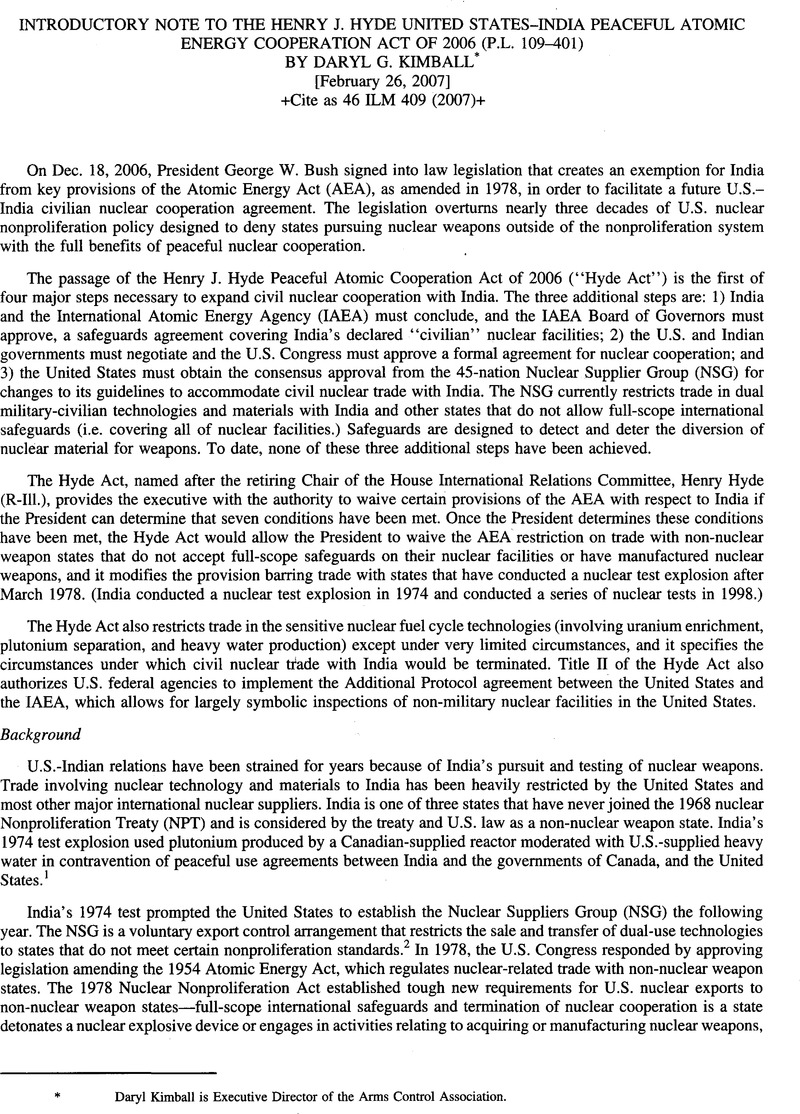Article contents
Henry J. Hyde United States-India Peaceful Atomic Energy Cooperation Act of 2006 (P.L. 109-401)
Published online by Cambridge University Press: 27 February 2017
Abstract

- Type
- Legislation
- Information
- Copyright
- Copyright © American Society of International Law 2007
References
* This text of the legislation was reproduced and reformatted from the text appearing at the Library of Congress website (visited March 16, 2007) <http://www.thomas.loc.gov. >
1 India's 1974 nuclear weapon test explosion used plutonium produced by a Canadian-supplied reactor (CIRUS) moderated with heavy water supplied by the United States under a 1956 contract stipulating that it be used only ‘ ‘for research into and the use of atomic energy ‘for peaceful purposes.’ “ To this day, the Indian government does not deny the 1974 test device used Canadian and U.S. equipment and materials, but asserts that it did not violate the terms of its U.S. and Canadian “peaceful uses” contract requirements because, according to Indian officials, the test was a “peaceful nuclear explosion.“ In January 2006, the U.S. State Department said that there is “factual uncertainty as to whether U.S.-supplied heavy water contributed to the production of the plutonium used for the explosive device, and the lack of a mutual understanding between the U.S. and India on the scope of the 1956 contract language. We have since made clear that we exclude so-called ‘peaceful nuclear explosions'—and any other nuclear explosive activity—from the scope of peaceful nuclear cooperation.“ Recently declassified documents show, however, that the United States and Canadian governments interpreted their agreements as “precluding all nuclear explosions on the grounds that any such explosion in tantamount to a nuclear weapons test” and made this interpretation clear to India before the 1974 bomb test. See: <http://www.armscontrol.org/country/india/Historic_Documents_India_Nuclear_Test.asp>
2 See < http://www.nsg-online.org >.
3 Russia Ships Nuclear Fuel to India, Arms Control Today, March 2001, at 32; Concern in West over Russian plan to sell nuclear reactor fuel to India, Fin. Times, March 16, 2006, at 11.
4 Such safeguards are knows as INFCIRC/66/Rev.2 safeguards, which were developed to preclude the use of designated civilian facilities for weapons purposes by non-nuclear weapon states that had not yet joined the NPT. Non-nuclear weapon state parties to the NPT are subject to ‘ ‘comprehensive safe-guards,” also known as INFCIRC/153 type safeguards, which apply to all nuclear facilities. Nuclear-weapon states parties to the NPT have “voluntary safeguards agreements” with the IAEA. Under this arrangement, the nuclear-weapon state designate which civilian facilities are eligible for safeguards and have the right to withdraw any facility from safeguards for national security reasons.
5 Squassoni, Sharon, “India's Nuclear Separation Plan: Issues and Views,” CRS Report for Congress, December 22, 2006.
6 Assuming each warhead requires 4-7 kg of weapons-grade plutonium. See: Institute for Science and International Security, “India's Military Plutonium Inventory, End 2004,” by David Albright, updated May 7,2005, available at < http://www.isis-online.org>
7 To date, talks on the FMCT have stymied by competing negotiating priorities at the 65-nation Conference on Disarmament (CD), which operates by consensus. The United States announced in 2004 that it did not believe an FMCT is effectively verifiable, which is contrary to the position of India and most other states at the CD.
8 Glenn Kessler, India Nuclear Deal May Face Hard Sell; Rice Set to Defend Landmark Accord She Orchestrated Without Congress, Wash. Post, April 3, 2006, at A01.
9 Condoleezza Rice, Our Opportunity with India, Wash. Post,March 13, 2006, at A15.
9 Condoleezza Rice, Our Opportunity with India, Wash. Post,March 13, 2006, at A15.
10 The commitments include: halting fissile material production for weapons; joining the 1996 Comprehensive Test Ban Treaty, and the pursuit of “negotiations in good faith on effective measures relating to cessation of the nuclear arms race at an early date and to nuclear disarmament'’ as required under Article VI of the NPT.
11 For a summary of these arguments, see: “Clarifying the Record on the July 18 Proposal for Nuclear Cooperation with India,” Joint Letter from Arms Control and Nonproliferation Experts to Members of Congress, February 14, 2006. Available from <http://www.armscontrol.org/pdf/20060214_India_Clarifying_Responses.pdf> Also see: Sam Nunn, Nuclear Pigin a Poke, Wall Street J., May 24, 2006, at 14.
12 See: David Albright and Susan Basu, Neither a Determined Proliferator Nor a Responsible Nuclear State: India's Record Needs Scrutiny, Institute for Science and International Security Issue Brief, April 5, 2006. Available from <http://www.is-online.org/publications/southasia/Indiacritique.pdf>
13 K Subrahmanyam, India and the Nuclear Deal, Times of India, Dec. 12, 2005. Available from < http://timesofindia.indiatimes.com/articleshow/1327306.cms >
14 The State Department replied to Lugar's questions and Mar-key's questions on Jan. 17,2006. See: < and http://www.armscontrol.org/pdf/20060117_India_Response_Lugar_Questions.pdf >
15 Singh said the United States had also agreed to “support an Indian effort to develop a strategic reserve of nuclear fuel to guard against any disruption of supply over the lifetime of India's reactors,'’ and if “a disruption of fuel supplies to India occurs, the United States and India would jointly convene a group of friendly supplier countries to … restore fuel supply to India.” To date, the precise nature of these assurances and their relationship to IAEA safeguards have not been settled.
16 Senate Foreign Relations Committee, April 5 and 26, 2006; House International Relations Committee, April 5 and May 11, 2006. For prepared testimony see: <http://www.armscontrol.org/projects/india/congressional.asp>
17 Article I of the NPT obligates declared nuclear_weapon states not “in any way to assist, encourage, or induce a non-nuclear weapon state to manufacture or otherwise acquire nuclear weapons ….“
18 The Henry Hyde Act also specifies that the President must determine that “all legal steps prior to signature” (meaning IAEA Board of Governors approval) have been completed before he can waive relevant sections of the AEA with respect to India.
19 For an excellent comparative analysis, see: Squassoni, Sharon and Parillo, Jill Marie, “U.S.-India Nuclear Cooperation: A Side-By-Side Comparison of CurrentLegislation,” CRS Re port for Congress, December 22, 2006. Available from <http://www.armscontrol.org/projects/india/crs/20061226CRSside_by_siderpt.pdf>
20 John Barry, New Delhi: No Deal, Newsweek, April 2, 2007, at 11.
- 1
- Cited by


